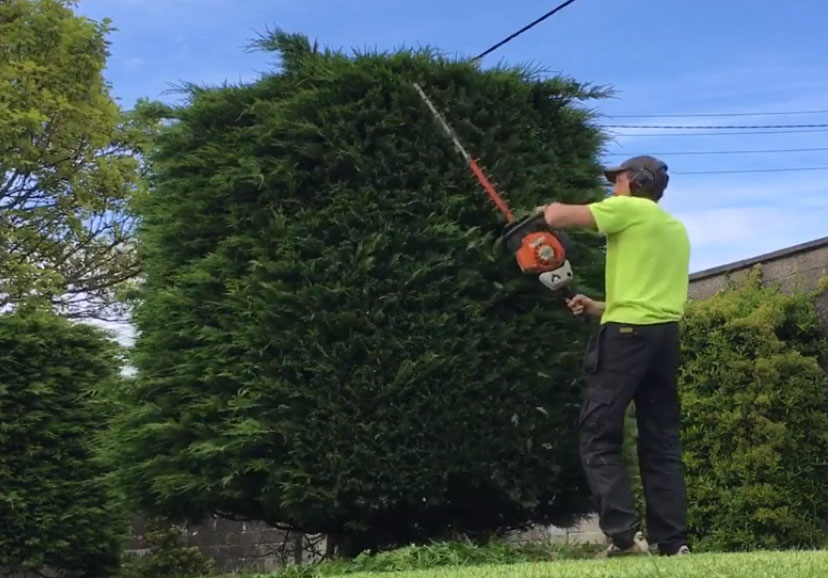Tree Trimming Service is a common request we get. We recommend you read through the great article on the book “HomeOwners complete guide to the Chainsaw” by “Brain J. Ruth and Jen W. Ruth”
One thing I feel strongly about is not using a chainsaw when cutting overhead. It is too easy for a branch to come crashing down onto me, bringing the running saw with it. In such situations, I recommend switching to a lopper, bow saw, or pole saw, or else calling in a professional.
Loppers are like a giant pair of scissors or garden pruners, but with long handles to get extra leverage. A good sharp pair of loppers can cut through branches up to two-inches thick.
A bow saw (sometimes called a bucksaw) is a handsaw with a large C-shaped tubular handle and a thin steel blade with large aggressive teeth. It can cut through branches of just about any thickness, but will quickly cut through limbs up to about four inches.
 Finally, there are a couple of kinds of pole saws. A manual pole saw has snap-together handle segments with a sharp steel blade at the end and often a lopper blade (controlled by a cord pull) on the back of the saw. Power pole saws are small gas- or electric-powered chainsaws on the end of extension poles.
Finally, there are a couple of kinds of pole saws. A manual pole saw has snap-together handle segments with a sharp steel blade at the end and often a lopper blade (controlled by a cord pull) on the back of the saw. Power pole saws are small gas- or electric-powered chainsaws on the end of extension poles. 1 Loppers handle overhead work. Loppers are perfect for trimming overhead errant branches, as on this ornamental crabapple tree. But be careful; branches can still fall on your head.
2 Getting into tight spots. It is easy to fit a pair of loppers into a tight spot that might be difficult to safely reach with a chainsaw. Even if you could get the chainsaw in there, the flexible branches would not cut easily and would tend to throw the saw around dangerously.
3 Bow saw works well. These limbs are easy to remove and clear working space while the tree is still safety, I used a bow saw to cut them off instead of a chainsaw.
4 Using a manual pole saw. Dead and unwanted branches high up in a tree can be reached with a manually operated pole saw. ahle to cut a dead branch straight down, Though the teeth are sharp, cutting from this distance can give you a workout. Note that I am Wearing a helmet!
5 Cutting live branches. On a live branch, I make a cut with the pole saw in three steps. First, I make a small undercut so my final cut does not strip the bark. Then, I make a top cut a little farther out to drop the branch. And, finally, I cut down to remove the stub.
6 Using powered pole saws. Gas- and electric-powered pole saws normally reach eight to fourteen feet in length. They are very unwieldy Because the weight of the saw is way out there on the end of a heavy pole, and so are the forces exerted by cutting with the moving chain. That’s why powered pole saws are professional tools best left to professional arborists. Because the saw itself is some distance from the user, the big risk is that cut branches fall upon the operator. The tool’s unwieldiness also poses the risk of inadvertently cutting any objects within reach of extended pole—including power and telephone lines.
Having read these cautions, if you insist upon using one, pay attention to these points:
- Keep bystanders far away.
- Follow all chainsaw operating rules, and wear complete personal protection equipment, including helmet and jacket with Kevlar-reinforced shoulder yoke.
- Since you’ll be looking up at the work, pay special attention to your footing and stable stance, and clear away any obstacles with tripping potential.
- Don’t power up the saw until you are ill Position and ready to cut.
- Don’t cut a branch that is directly above you, lest it fall on you.
 Trimming A Hedge:
Trimming A Hedge:It does not take long for a hedge to get out of control. If not trimmed regularly, it can grow so thick and high that you will need to climb onto a ladder to trim it. The usual power tool to trim a hedge is a hedge trimmer. They come in gas-, electric-, and battery-powered models.
You might think the chainsaw is a good alternative. The problem is, the moving chain deflects thin branches instead of cutting them. Trying to cut anything that can move is dangerous because the moving object also can move the saw, most likely to where you don’t want it to go. Trimming a hedge with a regular chainsaw is dangerous and should not be attempted. Fortunately, an inexpensive attachment for the saw bar makes the job possible. It looks like a giant comb with a tip guard and is called the Clip-N-Trim. It is available for about $20 from Granberg International.
The comb device weighs less than one-and-one-half pounds and will fit twelve-, fourteen-, sixteen-, and twenty-inch chainsaw bars. The fixed prongs on the attachment stop small branches from moving while the chain does the cutting. In addition to trimming hedges, you can use it for a Couple of other operations not normally recommended for the standard chainsaw—cutting heavy brush and Pruning small trees.
Mount comb device: Start by mounting the comb-like Clip-N-Trim attachment to the right side of the chainsaw bar using the bar bolts and a mounting bolt at the nose of the bar.You may notice I’m not wearing my helmet or face shield. That’s because this hedge has no large branches that might hit
Rake across face of hedge: Here I give a haircut to a large burning bush by ranking the attachment across the face of the hedge.
Giving a bush a haircut: Though it Will the trip or the bottom of the bar, I find it easiest to cut a straight line by starting with the bar almost vertical.
Finishing the hair cut: Then I lower the bar across the branches until the bar is horizontal.
Attacking thorny/thick growths: The comb attachment makes quick work of trimming thorny and thick growth such as this ornamental crabapple tree.
Handling saplings: Most of saplings on the side of this hill could be cut with the hedge-clipping attachment.

